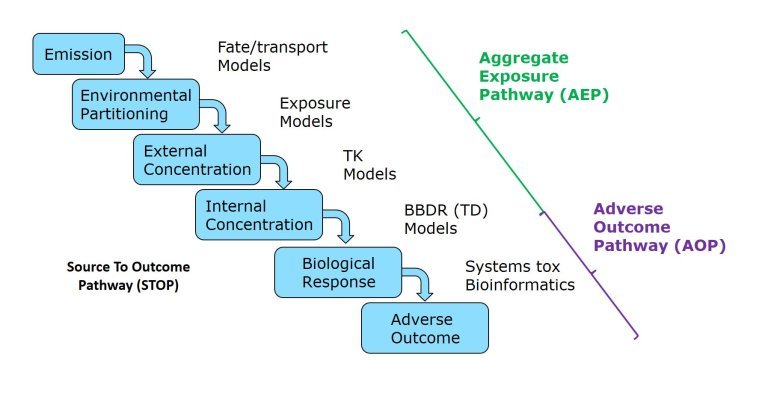NCTP
NIVA’s Computational Toxicology Program (NCTP) was officially launched in January 2018 to coordinate NIVA’s efforts within Computational and Systems (Eco)toxicology.
The program is managed by Prof. Dr. Knut Erik Tollefsen and team members from multiple sections at NIVA contribute to the effort (see team members, scholarships and guest researchers).
The program aims to consolidate and develop new tools and approaches for characterizing the Source To Outcome Pathway, STOP (Figure 1), and currently comprise a suite of experimental and computational methods. The Toolbox for developing the STOP framework address both exposure and toxicokinetics (e.g. the Aggregate Exposure Pathway, AEP), and toxicodynamics (e.g. Adverse Outcome Pathway, AOP).

Experimental Approaches
A set of acute and chronic whole organism bioassays using modified OECD and ISO test guidelines for microalgae, macroalgae/aquatic plants, crustaceans and fish will be used to populate the STOP continuum with relevant effect data. Functional (histopathology, protein expression, enzymatic activity etc.) and molecular profiling (RNA sequencing, microarrays, quantitative real-time PCR etc.) will be used to characterize the toxicity pathways triggered and to decipher the complex molecular interactions occurring along the AOP continuum. Potential ecological impact will be predicted in terms of loss of keystone species or taxa exhibiting ecological traits with known relevance for ecosystem functions and services. A summary of species and endpoints used is depicted in Table 1.
Computational Approaches
A suite of computational methods spanning the STOP continuum will be used to parameterize the AEP and AOP. A combination of source and exposure modelling, use of monitoring data, toxicokinetic (TK) modelling, biologically-based dose-response (TD) modelling, data mining using NIVA Risk Assessment Database, RAdb, and a suite of Bioinformatics and Biostatistics, are used to link data spanning different levels of organization. Prediction models for combined toxicity and cumulative risk are used to assess the effect of chemical mixtures and multiple stressors, whereas population and community modelling will be implemented for impact assessment where traditional laboratory data cannot be easily aquired.
A dedicated Source To Outcome Predictor (STOP) has been developed as a graphical user interphase (GUI) to facilitate data and analysis visualization using NIVAs RAdb.
